Care and Production of Clothing in Norwegian Homes: Environmental Implications of Mending and Making Practices
Abstract
:1. Introduction
- (1)
- How common are the different mending and making activities and have these changed during the past several years?
- (2)
- Who are the clothing menders and makers?
- (3)
- Are these practices related to consumers’ environmental opinions?
2. Background
3. Materials and Methods
4. Results
4.1. Prevalence of the Different Mending and Making Activities
4.2. Who Are the Clothing Menders and Makers?
4.3. Mending and Making Activities’ Connection to Environmental Opinions
- Recycling is an important environmental measure (five point likert scale from disagree to agree strongly)
- Climate change and extreme weather worry me (five point likert scale from disagree to agree strongly)
- New technologies will solve environmental problems without us needing to make big changes to our way of living (five point likert scale from disagree to agree strongly)
- Have environmental problems caused you to reduce your clothing purchases? (Answering alternatives: yes, no, or do not know. Do not know answers were excluded from the analysis.)
- Report to have reduced their clothing purchases for environmental reasons
- Are more worried about climate change and extreme weather
- Think that recycling is an important environmental measure
5. Discussion
6. Conclusions
Author Contributions
Funding
Acknowledgments
Conflicts of Interest
Appendix A
| Maintenance | Percentage That Carries Out the Activity on an Average Day | Time Use Among Those That Carry Out the Activity (Hours:Minutes) | Average Time Use Among All Respondents (Hours:Minutes) | |||||||||
|---|---|---|---|---|---|---|---|---|---|---|---|---|
| Year | 1980 | 1990 | 2000 | 2010 | 1980 | 1990 | 2000 | 2010 | 1980 | 1990 | 2000 | 2010 |
| Average | 5% | 3% | 2% | 1% | 1:00 | 1:07 | 0:52 | 0:42 | 0:03 | 0:02 | 0:01 | 0:00 |
| Men | 1% | 1% | 1% | 0% | 0:47 | 0:44 | 1:23 | 0:30 | 0:00 | 0:00 | 0:00 | 0:00 |
| Women | 9% | 5% | 4% | 1% | 1:01 | 1:09 | 0:47 | 0:44 | 0:06 | 0:04 | 0:02 | 0:01 |
| Age 16–24 | 3% | 2% | 1% | 0% | 1:00 | - | - | - | 0:02 | 0:01 | 0:00 | 0:00 |
| Age 25–44 | 5% | 3% | 1% | 1% | 0:57 | 1:04 | 0:34 | 0:34 | 0:03 | 0:02 | 0:00 | 0:00 |
| Age 45–66 | 6% | 4% | 3% | 1% | 1:03 | 1:16 | 1:09 | 0:48 | 0:04 | 0:03 | 0:02 | 0:01 |
| Age 67–74 | 5% | 5% | 3% | 3% | - | - | 0:32 | 0:43 | 0:03 | 0:03 | 0:01 | 0:01 |
| Knitting | Percentage That Carries Out the Activity on an Average Day | Time Use Among Those That Carry Out the Activity (Hours:Minutes) | Average Time Use Among All Respondents (Hours:Minutes) | |||||||||
|---|---|---|---|---|---|---|---|---|---|---|---|---|
| Year | 1980 | 1990 | 2000 | 2010 | 1980 | 1990 | 2000 | 2010 | 1980 | 1990 | 2000 | 2010 |
| Average | 7% | 6% | 3% | 3% | 1:06 | 1:14 | 1:02 | 1:33 | 0:04 | 0:04 | 0:02 | 0:02 |
| Men | 0% | 0% | 0% | 0% | 0:00 | 0:00 | 0:00 | 0:00 | ||||
| Women | 12% | 11% | 6% | 5% | 1:05 | 1:14 | 1:22 | 1:33 | 0:08 | 0:08 | 0:05 | 0:05 |
| Age 16–24 | 4% | 3% | 1% | 0% | 0:52 | 1:16 | - | - | 0:02 | 0:02 | 0:00 | 0:00 |
| Age 25–44 | 7% | 5% | 2% | 1% | 1:07 | 1:05 | 1:05 | 1:08 | 0:05 | 0:03 | 0:01 | 0:01 |
| Age 45–66 | 7% | 7% | 4% | 4% | 1:11 | 1:16 | 1:31 | 1:32 | 0:05 | 0:05 | 0:04 | 0:04 |
| Age 67–74 | 8% | 11% | 10% | 10% | 1:06 | 1:29 | 1:19 | 1:49 | 0:05 | 0:01 | 0:08 | 0:01 |
References
- Gracey, F.; Moon, D. Valuing Our Clothes: The Evidence Base; WRAP: Banbury, UK, 2012; p. 69. Available online: http://www.wrap.org.uk/sites/files/wrap/10.7.12%20VOC-%20FINAL.pdf (accessed on 9 March 2018).
- Cooper, T.; Hill, H.; Kininmonth, J.; Townsend, K.; Hughes, M.; Shorrocks, J.; Knox, A.; Fisher, T.; Saicheua, V. Design for Longevity—Guidance on Increasing the Active Life of Clothing; Wrap: Banbury, UK, 2013; Available online: http://www.wrap.org.uk/sites/files/wrap/Design%20for%20Longevity%20Report_0.pdf (accessed on 13 March 2018).
- Cooper, T.; Claxton, S.; Hill, H.; Holbrook, K.; Hughes, M.; Knox, A.; Oxborrow, L. Clothing Longevity Protocol; Project Code: REC100-008; Nottingham Trent University Banbury: Nottingham, UK, 2014; p. 11. Available online: http://www.wrap.org.uk/sites/files/wrap/Clothing%20Longevity%20Protocol_0.pdf (accessed on 8 May 2018).
- Fisher, T.; Cooper, T.; Woodward, S.; Hiller, A.; Goworek, H. Public Understanding of Sustainable Clothing: A Report to the Department for Environment Food and Rural Affairs; Defra: London, UK, 2008. Available online: http://randd.defra.gov.uk/Document.aspx?Document=EV0405_7666_FRP.pdf (accessed on 2 February 2018).
- Lapolla, K.; Sanders, E.B.-N. Using cocreation to engage everyday creativity in reusing and repairing apparel. Cloth. Text. Res. J. 2015, 33, 183–198. [Google Scholar] [CrossRef]
- Bergin, O. Vivienne Westwood: ‘I Don’t Wash My Own Clothes Very Often’. Telegraph.co.uk. 25 November 2010. Available online: http://fashion.telegraph.co.uk/news-features/TMG8160552/Vivienne-Westwood-I-dont-wash-my-own-clothes-very-often.html (accessed on 10 May 2018).
- Gwilt, A. What prevents people repairing clothes? An investigation into community-based approaches to sustainable product service systems for clothing repair. Mak. Futures J. 2014, 3, 332–337. Available online: http://shura.shu.ac.uk/id/eprint/8125 (accessed on 9 March 2018).
- Holroyd, A.T. Perceptions and practices of dress-related leisure: Shopping, sorting, making and mending. Ann. Leis. Res. 2016, 19, 275–293. [Google Scholar] [CrossRef]
- Laitala, K.; Boks, C. Sustainable clothing design: Use matters. J. Des. Res. 2012, 10, 121–139. [Google Scholar] [CrossRef]
- McLaren, A.; McLauchlan, S. Crafting sustainable repairs: Practice-based approaches to extending the life of clothes. In Proceedings of the Plate Product Lifetimes and the Environment Conference, Nottingham, UK, 17–19 June 2015; Cooper, T., Braithwaite, N., Moreno, M., Salvia, G., Eds.; Nottingham Trent University, CADBE: Nottingham, UK, 2015; pp. 221–228. Available online: http://www.plateconference.org/crafting-sustainable-repairs-practice-based-approaches-extending-life-clothes/ (accessed on 11 May 2018).
- Klepp, I.G.; Laitala, K. Shared use and owning of clothes: Borrow, steal, or inherit. In Contemporary Collaborative Consumption—Trust and Reciprocity Revisited; Cruz, I.S., Ganga, R., Wahlen, S., Eds.; Springer: Wiesbaden, Germany, 2018; pp. 153–177. [Google Scholar]
- Klepp, I.G. Hvorfor Går Klær ut av Bruk? Avhending Sett i Forhold Til Kvinners Klesvaner [Why Are Clothes No Longer Used? Clothes Disposal in Relationship to Women’s Clothing Habits]; SIFO: Oslo, Norway, 2001; Available online: http://www.sifo.no/files/file48469_rapport2001-03web.pdf (accessed on 11 February 2016).
- Sennett, R. The Craftsman; Penguin Books: London, UK, 2009. [Google Scholar]
- Holroyd, A.T. Folk Fashion: Understanding Homemade Clothes; IB Tauris: London, UK, 2017; p. 236. [Google Scholar]
- Bresee, R.R. General effects of ageing on textiles. J. Am. Inst. Conserv. 1986, 25, 39–48. [Google Scholar] [CrossRef]
- Baker, M.M. Clothing Repair; University of Kentucky Cooperative Extension: Lexington, KY, USA, 2007; Available online: https://fleming.ca.uky.edu/files/clothing_repair.pdf (accessed on 11 May 2018).
- Klepp, I.G. Fra Eggvendte Laken til Festlig Lapp På Baken—Råd og Teknikker for å Økonomisere Med Tekstiler 1900–2000; SIFO: Lysaker, Norway, 2000; Available online: http://www.sifo.no/files/file48391_arbeidsrapport3-2000.pdf (accessed on 17 January 2016).
- Johnson, D. A new direction in clothing construction. J. Home Econ. 1960, 52, 752–753. [Google Scholar]
- Aalto, K. Kuka Pesee Suomen Pyykit?: Tekstiilienhoito Kotitalouksissa ja Tekstiilienhoitopalvelut; Kuluttajatutkimuskeskus: Helsinki, Finland, 2003. [Google Scholar]
- Schwarz, M.; Yair, K. Making Value: Craft & the Economic and Social Contribution of Makers; Crafts Council: London, UK, 2010; p. 122. Available online: http://www.craftscouncil.org.uk/content/files/making_value_full_report.pdf (accessed on 13 August 2018).
- McIntyre, M.H. Consuming Craft: The Contemporary Craft Market in a Changing Economy; Crafts Council: London, UK, 2010; p. 65. Available online: http://www.craftscouncil.org.uk/content/files/consuming_craft_full_report.pdf (accessed on 13 August 2018).
- Lewis-Hammond, S. The Rise of Mending: How Britain Learned to Repair Clothes Again. The Guardian. 19 May 2014. Available online: https://www.theguardian.com/lifeandstyle/2014/may/19/the-rise-of-mending-how-britain-learned-to-repair-clothes-again (accessed on 12 April 2018).
- Orange, R. Waste Not Want Not: Sweden to Give Tax Breaks for Repairs. The Guardian. 19 September 2016. Available online: https://www.theguardian.com/world/2016/sep/19/waste-not-want-not-sweden-tax-breaks-repairs (accessed on 12 April 2018).
- Fox, S. Third wave do-it-yourself (diy): Potential for prosumption, innovation, and entrepreneurship by local populations in regions without industrial manufacturing infrastructure. Technol. Soc. 2014, 39, 18–30. [Google Scholar] [CrossRef]
- Tojo, N.; Kogg, B.; Kiørboe, N.; Kjær, B.; Aalto, K. Prevention of Textile Waste: Material Flows of Textiles in Three Nordic Countries and Suggestions on Policy Instruments; Nordic Council of Ministers: Copenhagen, Denmark, 2012; p. 121. Available online: http://www.norden.org/en/publications/publikationer/2012-545 (accessed on 4 September 2017).
- Nielsen, M.-B.O. Norvegr—Norges Historie. Bind 4: Etter 1914; Aschehoug: Oslo, Norway, 2011. [Google Scholar]
- Klepp, I.G.; Laitala, K. Nisseluelandet—The impact of local clothes for the survival of a textile industry in norway. Fash. Pract. 2018, 10, 171–195. [Google Scholar] [CrossRef]
- Hebrok, M.; Klepp, I.G. Wool is a knitted fabric that itches, isn’t it? Crit. Stud. Fash. Beaut. 2014, 5, 67–93. [Google Scholar] [CrossRef]
- Hebrok, M.; Klepp, I.G.; Turney, J. Wool you wear it?—Woollen garments in norway and the united kingdom. Cloth. Cult. 2016, 3, 67–84. [Google Scholar] [CrossRef]
- Klepp, I.G.; Laitala, K.; Tobiasson, T.S. Woolbed—Sweet Dreams in Merino; SIFO: Oslo, Norway, 2016; p. 203. Available online: http://sifo.no/files/file80443_oppdragsrapport_no_2_2016_-_woolbed_final.pdf (accessed on 27 October 2016).
- Cooper, T.; Fisher, T.; Hiller, A.; Goworek, H.; Woodward, S. Excessive speed/short lives—Attitudes to clothing longevity and disposal. In Proceedings of the LeNS Conference Sustainability in Design, Bangalore, India, 29 September–1 October 2010; Ceschin, F., Vezzoli, C., Zhang, J., Eds.; pp. 728–737. Available online: https://bura.brunel.ac.uk/bitstream/2438/6726/3/Ceschin%20Vezzoli%20Zhang_2010_LeNS%20proceedings_vol1.pdf (accessed on 13 August 2018).
- Ekström, K.M.; Gustafsson, E.; Hjelmgren, D.; Salomonson, N. Mot en Mer Hållbar Konsumtion: En Studie om Konsumenters Anskaffning och Avyttring av Kläder [Towards a More Sustainable Consumption: A Study of Consumers’ Acquisition and Disposal of Clothing]; University of Borås: Borås, Sweden, 2012; p. 143. Available online: http://bada.hb.se/bitstream/2320/10630/1/Vetenskapnr20.pdf (accessed on 23 September 2017).
- Vaage, O.F. Tidene skifter. Tidsbruk 1971-2010; Statistics Norway: Oslo/Kongsvinger, Norway, 2012; p. 233. Available online: http://www.ssb.no/emner/00/02/20/sa125/sa125.pdf (accessed on 9 November 2016).
- Statistics Norway. Table 11800: Population 31.12, by Age (c) 2015–2017, 15 March 2018 ed.; Kostra-Municipality-State-Reporting; SSB: Oslo, Norway, 2018; Available online: https://www.ssb.no/en/statbank/table/11800 (accessed on 8 May 2018).
- TNS Gallup. Sifo-Surveyen 2011; TNS Gallup: Oslo, Norway, 2011. [Google Scholar]
- De leeuw, E.; Hox, J.; Dillman, D. International Handbook of Survey Methodology; Taylor & Francis Group: New York, NY, USA, 2008; p. 560. [Google Scholar]
- Norum, P.S. Examination of apparel maintenance skills and practices: Implications for sustainable clothing consumption. Fam. Consum. Sci. Res. J. 2013, 42, 124–137. [Google Scholar] [CrossRef]
- Undheim, K.; Døving, R.; Moe, H.T. Skammens tjenester. Magma—Econas Tidsskrift for Økonomi og Ledelse 2015, 6, 44–52. [Google Scholar]
- Klepp, I.G.; Vramo, L.; Laitala, K. Too old: Clothes and value in norwegian and indian wardrobes. In Global Textile Encounters; Nosch, M.-L., Feng, Z., Varadrajan, L., Eds.; Oxbow Books: Oxford, UK, 2014; Volume 20, pp. 237–244. [Google Scholar]
- Iyengar, S.; Shewfelt, S.; Ivanchenko, R.; Menzer, M.; Shingler, T. How a Nation Engages with Art: Highlights from the 2012 Survey of Public Participation in the Arts; National Endowment for the Arts: Washington, DC, USA, 2013. Available online: https://www.arts.gov/sites/default/files/highlights-from-2012-sppa-revised-oct-2015.pdf (accessed on 9 March 2018).
- The UK Hand Knitting Association. About Us. Available online: http://www.ukhandknitting.com/about-us (accessed on 11 June 2018).
- Kaufmann, J.-C. Dirty Linen: Couples and Their Laundry; Middlesex University Press: London, UK, 1998. [Google Scholar]
- Klepp, I.G. Skittentøyets Kulturhistorie-Hvorfor Kvinner Vasker Klær; Novus Forlag: Oslo, Norway, 2006. [Google Scholar]
- Klepp, I.G. Klippe, klipp, klippe: Kjønnsarbeidsdeling på frammarsj. Tidsskrift Kulturforskning 2005, 4, 23–40. [Google Scholar]
- Miller, D. A theory of Shopping; Polity Press: Cambridge, UK, 1998; p. 180. [Google Scholar]
- Mason, R. The meaning and value of home-based craft. Int. J. Art Des. Educ. 2005, 24, 261–268. [Google Scholar] [CrossRef]
- Mason, R. Craft Education in Secondaryschools at Key Stages 3 and 4: Pupils as Makers; Crafts Council of England: London, UK, 1998. [Google Scholar]
- Houghton, N. An Investigation into Pupils’ Views about Craft and Its Educational Value; Roehampton University: London, UK, 2000. [Google Scholar]
- Langley, E.; Durkacz, S.; Tanase, S. Clothing Longevity and Measuring Active Use; Wrap: Banbury, UK, 2013; Available online: http://www.wrap.org.uk/sites/files/wrap/priv_download/Clothing%20longevity%20SUMMARY%20REPORT.pdf (accessed on 21 March 2018).
- Brosdahl, D.J.C.; Carpenter, J.M. Consumer knowledge of the environmental impacts of textile and apparel production, concern for the environment, and environmentally friendly consumption behavior. J. Text. Appar. Technol. Manag. 2010, 6, 1–9. Available online: http://ojs.cnr.ncsu.edu/index.php/JTATM/article/download/854/730 (accessed on 25 January 2016).
- Markkula, A.; Moisander, J. Discursive confusion over sustainable consumption: A discursive perspective on the perplexity of marketplace knowledge. J. Consum. Policy 2012, 35, 105–125. [Google Scholar] [CrossRef]
- Fazio, R.H.; Zanna, M.P.; Cooper, J. Direct experience and attitude-behavior consistency: An information processing analysis. Pers. Soc. Psychol. Bull. 1978, 4, 48–51. [Google Scholar] [CrossRef]
- Fletcher, K.; Klepp, I.G. Opening Up the Wardrobe: A Methods Book; Novus: Oslo, Norway, 2017; p. 195. [Google Scholar]
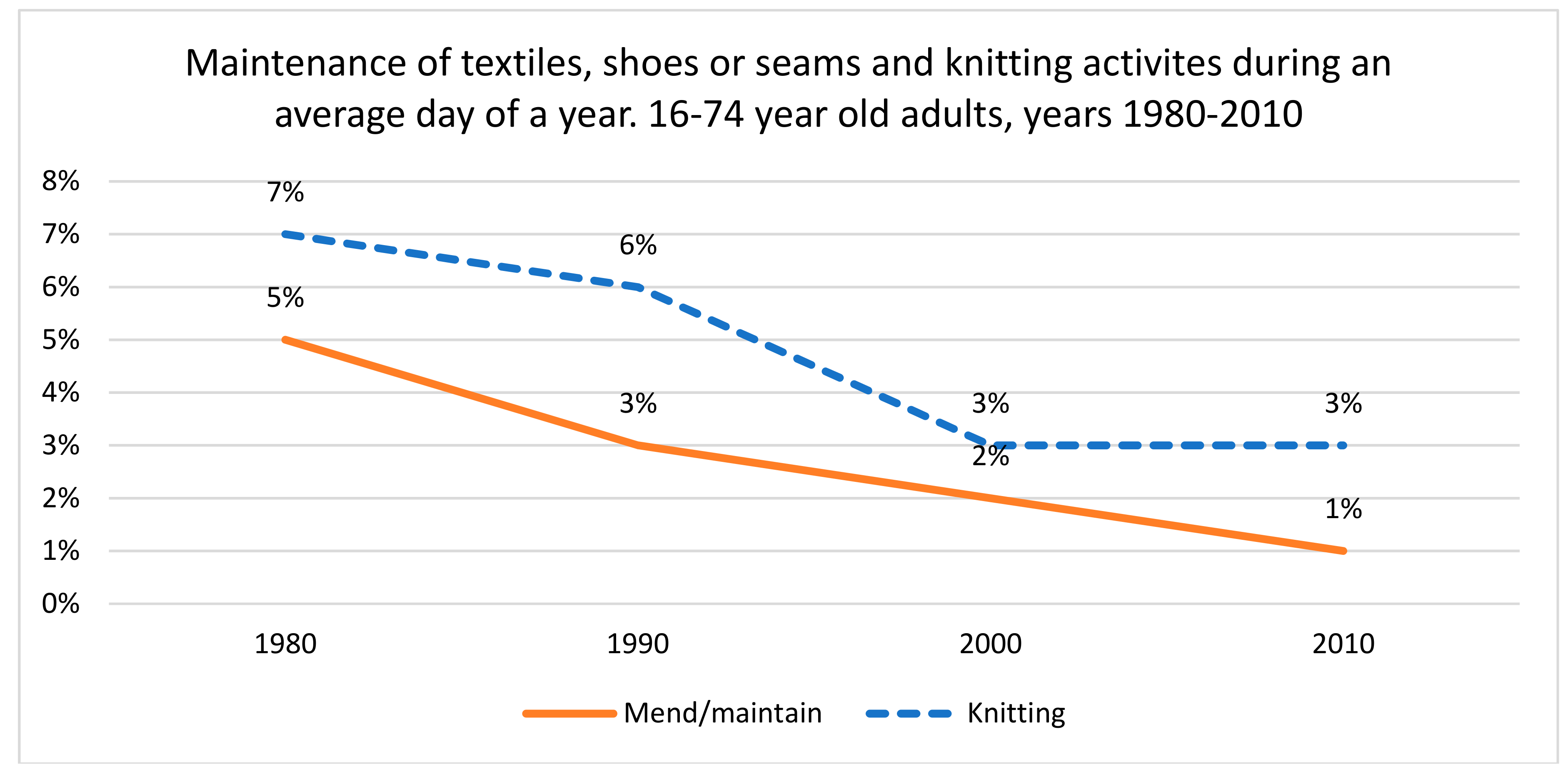
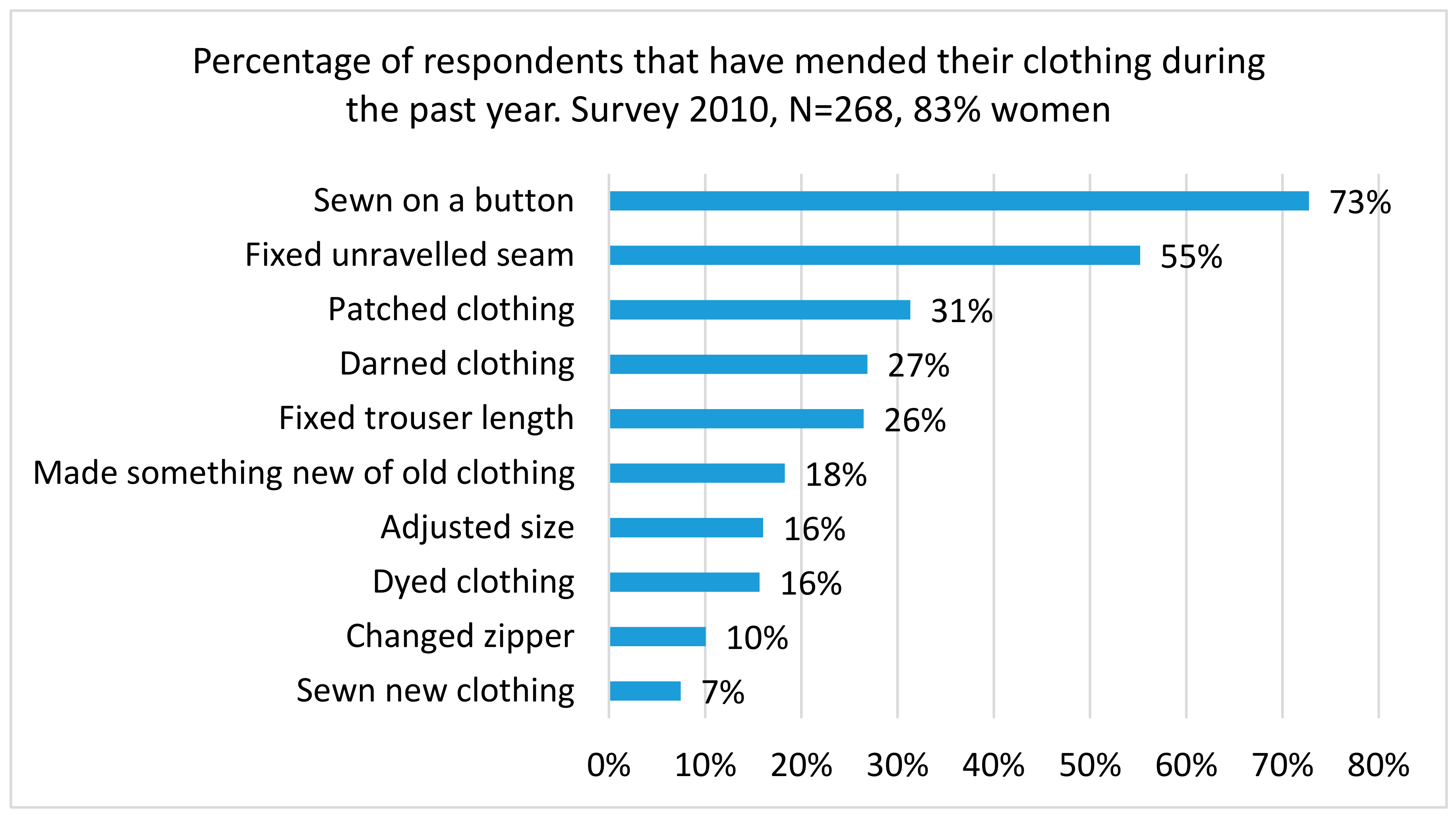
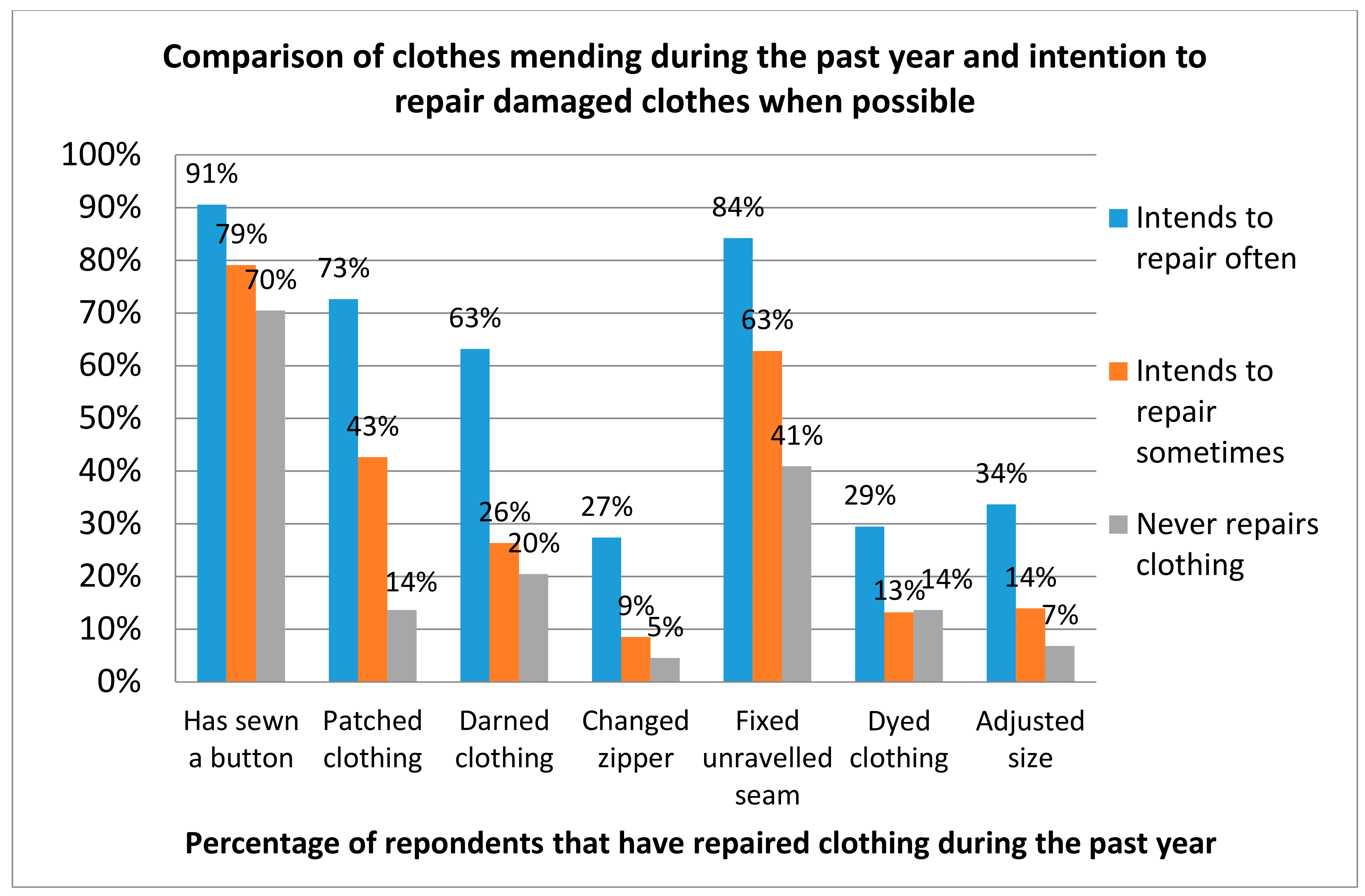
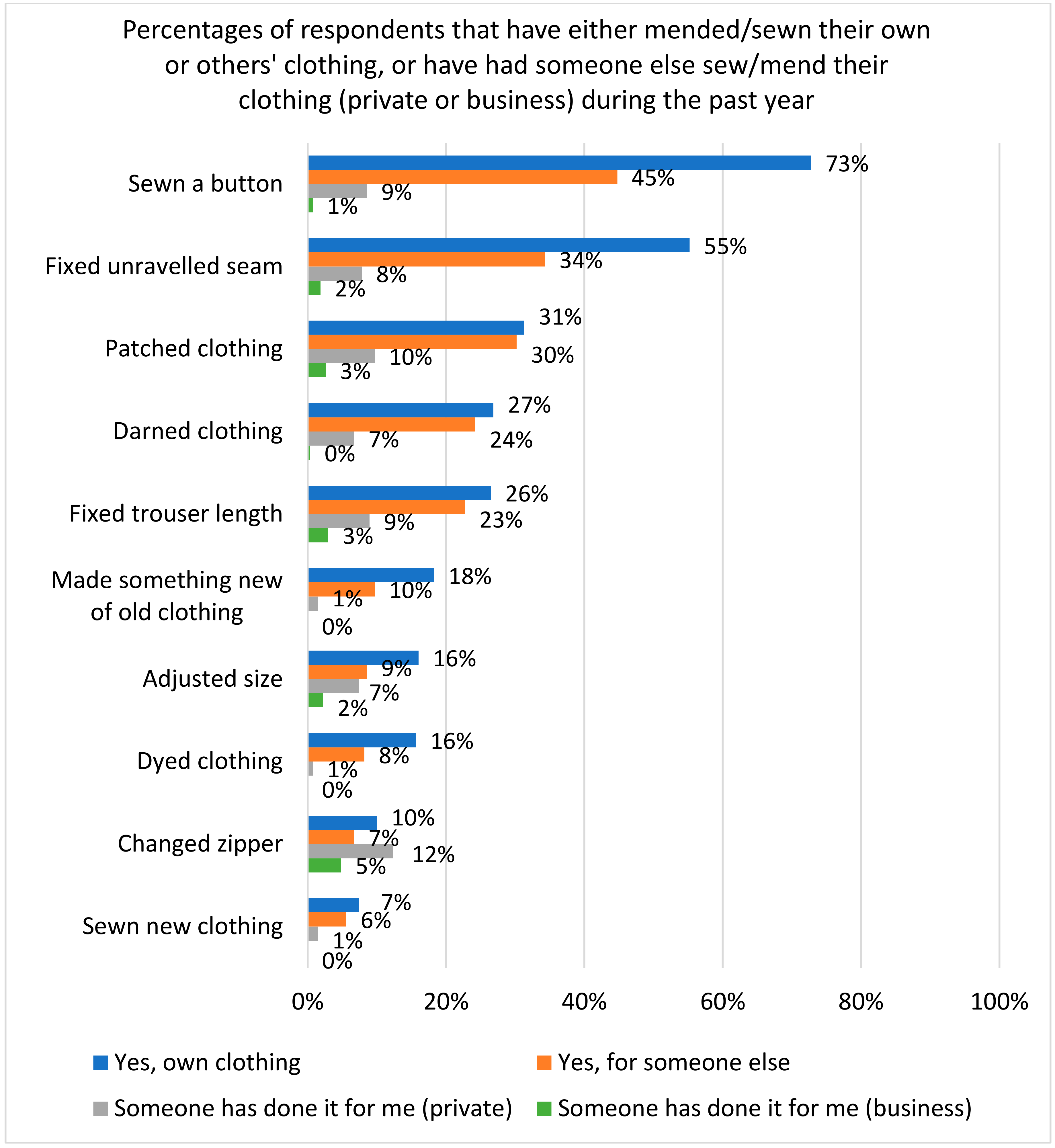
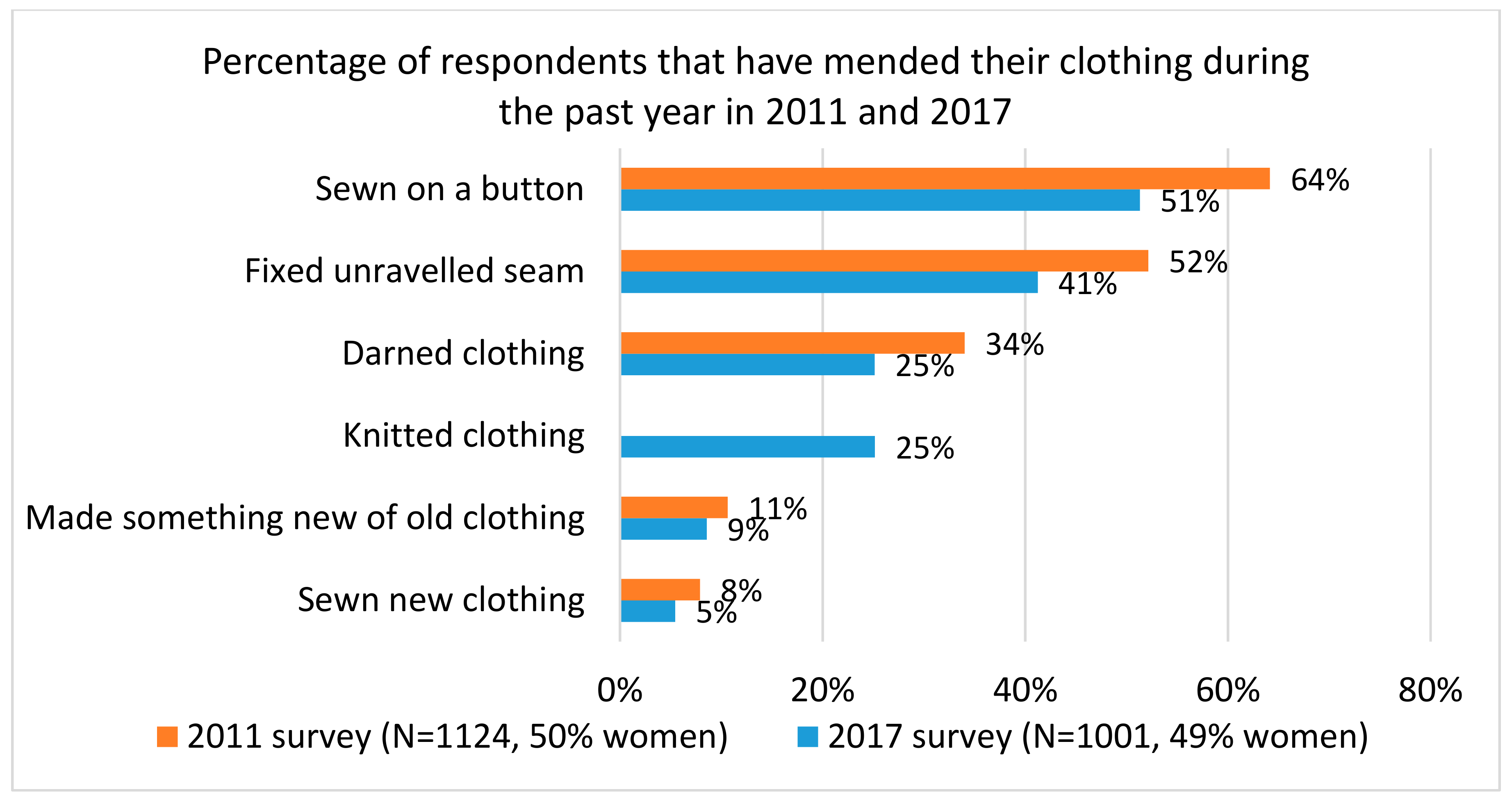
| Background Variables | Sample 2010 1 | Sample 2011 2 | Sample 2017 2 | Norwegian Population 3 | |
|---|---|---|---|---|---|
| Number of respondents (N) | 268 | 1124 | 1001 | - | |
| Gender | Male | 17% | 50% | 51% | 50% |
| Female | 83% | 50% | 49% | 50% | |
| Average age | 37.1 | 45.2 | 45.9 | 47.9 | |
| Age group | Below 24 | 11% | 10% | 11% | 11% |
| 25–39 | 51% | 29% | 28% | 26% | |
| 40–59 | 34% | 38% | 36% | 34% | |
| 60+ | 4% | 23% | 25% | 29% | |
| Sewn on a Button | Fixed Unravelled Seam | Darned Clothing | Made Something New of Old Clothes | Sewn New Clothing | |||||||
|---|---|---|---|---|---|---|---|---|---|---|---|
| (%) | Chi-Square | (%) | Chi-Square | (%) | Chi-Square | (%) | Chi-Square | (%) | Chi-Square | ||
| All | Mean | 64 | 52 | 34 | 11 | 8 | |||||
| Gender | Male | 45 | χ2 = 187.694, | 30 | χ2 = 238.545, | 17 | χ2 = 154.018, | 4 | χ2 = 46.628, | 2 | χ2 = 51.787, |
| Female | 84 | p < 0.000 ** | 76 | p < 0.000 ** | 52 | p < 0.000 ** | 17 | p < 0.000 ** | 14 | p < 0.000 ** | |
| Age | 18–24 | 59 | χ2 = 13.275, | 44 | χ2 = 15.651, | 23 | χ2 = 14.252, | 18 | χ2 = 8.058, | 7 | χ2 = 7.074, |
| 25–39 | 60 | p = 0.004 ** | 48 | p = 0.001 ** | 33 | p = 0.003 ** | 11 | p = 0.045 * | 10 | p = 0.070 | |
| 40–59 | 64 | 53 | 34 | 9 | 5 | ||||||
| 60+ | 73 | 62 | 43 | 10 | 10 | ||||||
| Children | No children | 67 | χ2 = 9.499, | 54 | χ2 = 4.450, | 36 | χ2 = 1.815, | 12 | χ2 = 2.854, | 9 | χ2 = 4.574, |
| Children below age of 15 | 58 | p = 0.002 ** | 48 | p = 0.035 * | 31 | p = 0.178 | 8 | p = 0.091 | 5 | p = 0.032 * | |
| Activity | Student | 64 | χ2 = 5.911, | 51 | χ2 = 8.234, | 27 | χ2 = 8.024, | 16 | χ2 = 5.797, | 6 | χ2 = 3.011, |
| Working | 62 | p = 0.052 | 50 | p = 0.016 * | 34 | p = 0.018 * | 9 | p = 0.055 | 7 | p = 0.222 | |
| Non-working | 71 | 60 | 41 | 12 | 10 | ||||||
| Economic situation | Good | 63 | χ2 = 2.982, | 52 | χ2 = 0.485, | 34 | χ2 = 2.095, | 10 | χ2 = 3.135, | 7 | χ2 = 3.954, |
| Bad | 70 | p = 0.084 | 55 | p = 0.535 | 40 | p = 0.148 | 14 | p = 0.077 | 12 | p = 0.047 * | |
| Education | Elementary, secondary or vocational | 63 | χ2 = 4.879, | 52 | χ2 < 0.000, | 33 | χ2 = 4.063, | 11 | χ2 = 0.024, | 8 | χ2 = 0.173, |
| College or university | 70 | p = 0.027 * | 52 | p = 0.994 | 39 | p = 0.044 * | 11 | p = 0.877 | 9 | p = 0.678 | |
| Sewn on a Button | Fixed Unravelled Seam | Darned Clothing | Made Something New of Old Clothes | Sewn New Clothing | Knitted Clothing | ||||||||
|---|---|---|---|---|---|---|---|---|---|---|---|---|---|
| (%) | Chi-Square | (%) | Chi-Square | (%) | Chi-Square | (%) | Chi-Square | (%) | Chi-Square | (%) | Chi-Square | ||
| All | Mean | 51 | 41 | 25 | 9 | 5 | 25 | ||||||
| Gender | Male | 36 | χ2 = 108.446, | 20 | χ2 = 188.652, | 10 | χ2 = 131.978, | 3 | χ2 = 36.558, | 1 | χ2 = 33.588, | 3 | χ2 = 271.208, |
| Female | 69 | p < 0.000 ** | 63 | p < 0.000 ** | 41 | p < 0.000 ** | 14 | p < 0.000 ** | 10 | p < 0.000 ** | 48 | p < 0.000 ** | |
| Age | 18–24 | 37 | 32 | 10 | 9 | 6 | 27 | ||||||
| 25–39 | 44 | χ2 = 34.186, | 34 | χ2 = 20.173, | 19 | χ2 = 27.828, | 9 | χ2 = 0.520, | 7 | χ2 = 1.852, | 23 | χ2 = 11.325, | |
| 40–59 | 53 | p <0.000 ** | 45 | p <0.000 ** | 31 | p <0.000 ** | 8 | p = 0.914 | 4 | p = 0.604 | 22 | p = 0.010 * | |
| 60+ | 65 | 50 | 31 | 9 | 5 | 33 | |||||||
| Children | No children | 53 | χ2 = 0.862, | 41 | χ2 = 0.181, | 24 | χ2 = 1.501, | 8 | χ2 = 1.064, | 5 | χ2 = 0.019, | 26 | χ2 = 1.260, |
| Children below age of 18 | 50 | p = 0.353 | 43 | p = 0.671 | 28 | p = 0.221 | 10 | p = 0.302 | 6 | p = 0.890 | 23 | p = 0.262 | |
| Activity | Student | 45 | χ2 = 7.613, | 41 | χ2 = 4.224, | 16 | χ2 = 8.231, | 11 | χ2 = 1.405, | 10 | χ2 = 6.675, | 25 | χ2 = 6.492, |
| Working | 50 | p = 0.022 * | 40 | p = 0.121 | 25 | p = 0.016 * | 8 | p = 0.495 | 4 | p = 0.036* | 23 | p = 0.039 * | |
| Non-working | 59 | 47 | 30 | 9 | 6 | 31 | |||||||
| Education | Elementary, secondary or vocational | 46 | χ2 = 9.927, | 37 | χ2 = 5.219, | 21 | χ2 = 7.155, | 6 | χ2 = 5.535, | 4 | χ2 = 2.387, | 23 | χ2 = 1.404, |
| College or university | 56 | p = 0.002 ** | 45 | p = 0.022 * | 28 | p = 0.007 ** | 10 | p = 0.019 * | 6 | p = 0.122 | 27 | p = 0.236 | |
| New Technologies Will Solve Environmental Problems (from 1 Disagree Strongly to 5 Agree Strongly) | Climate Change and Extreme Weather Worry Me (from 1 Disagree Strongly to 5 Agree Strongly) | Recycling Is An Important Environmental Measure (from 1 Disagree Strongly to 5 Agree Strongly) | Reduced Clothing Purchases for Environmental Reasons (0 = No, 1 = Yes) | ||||||
|---|---|---|---|---|---|---|---|---|---|
| Mean | Anova | Mean | Anova | Mean | Anova | Mean | Anova | ||
| Sewn on a button | Yes | 3.00 | F(1, 1112) = 0.422, p = 0.516 | 3.28 | F(1, 1111) = 15.619, p < 0.000 ** | 4.43 | F(1, 1112) = 9.113, p = 0.003 ** | 0.22 | F(1, 982) = 11.810, p = 0.001 ** |
| No | 3.04 | 2.98 | 4.27 | 0.13 | |||||
| Fixed unravelled seam | Yes | 2.98 | F(1, 1109) = 1.536, p = 0.216 | 3.31 | F(1, 1108) = 15.853, p < 0.000 ** | 4.46 | F(1, 1110) = 13.034, p < 0.000 ** | 0.24 | F(1, 977) = 18.954, p < 0.000 ** |
| No | 3.05 | 3.03 | 4.28 | 0.13 | |||||
| Darned clothing | Yes | 2.88 | F(1, 1100) = 8.883, p = 0.003 ** | 3.40 | F(1, 1099) = 20.025, p < 0.000 ** | 4.53 | F(1, 1101) = 18.030, p <0.000 ** | 0.31 | F(1, 971) = 41.672, p < 0.000 ** |
| No | 3.07 | 3.06 | 4.30 | 0.14 | |||||
| Made something new of old clothing | Yes | 2.91 | F(1, 1106) = 1.373, p = 0.242 | 3.48 | F(1, 1105) = 8.489, p = 0.004 ** | 4.61 | F(1, 1107) = 10.197, p = 0.001 ** | 0.43 | F(1, 977) = 41.686, p < 0.000 ** |
| No | 3.02 | 3.14 | 4.35 | 0.17 | |||||
| Sewn new clothing | Yes | 2.92 | F(1, 1110) = 0.763, p = 0.383 | 3.46 | F(1, 1108) = 5.819, p = 0.016 * | 4.65 | F(1, 1110) = 10.136, p = 0.001 ** | 0.33 | F(1, 981) = 10.113, p = 0.002 ** |
| No | 3.01 | 3.14 | 4.35 | 0.18 | |||||
© 2018 by the authors. Licensee MDPI, Basel, Switzerland. This article is an open access article distributed under the terms and conditions of the Creative Commons Attribution (CC BY) license (http://creativecommons.org/licenses/by/4.0/).
Share and Cite
Laitala, K.; Klepp, I.G. Care and Production of Clothing in Norwegian Homes: Environmental Implications of Mending and Making Practices. Sustainability 2018, 10, 2899. https://doi.org/10.3390/su10082899
Laitala K, Klepp IG. Care and Production of Clothing in Norwegian Homes: Environmental Implications of Mending and Making Practices. Sustainability. 2018; 10(8):2899. https://doi.org/10.3390/su10082899
Chicago/Turabian StyleLaitala, Kirsi, and Ingun Grimstad Klepp. 2018. "Care and Production of Clothing in Norwegian Homes: Environmental Implications of Mending and Making Practices" Sustainability 10, no. 8: 2899. https://doi.org/10.3390/su10082899
APA StyleLaitala, K., & Klepp, I. G. (2018). Care and Production of Clothing in Norwegian Homes: Environmental Implications of Mending and Making Practices. Sustainability, 10(8), 2899. https://doi.org/10.3390/su10082899






